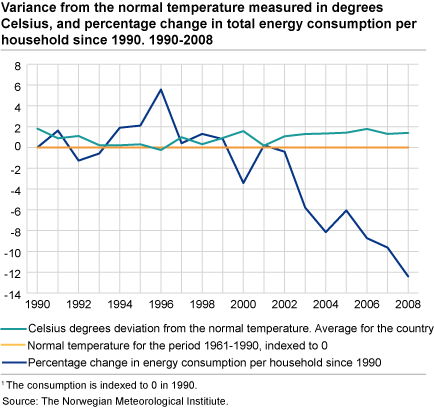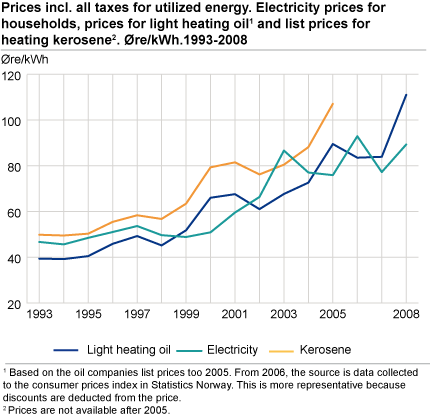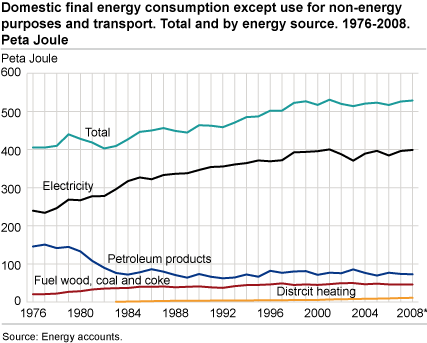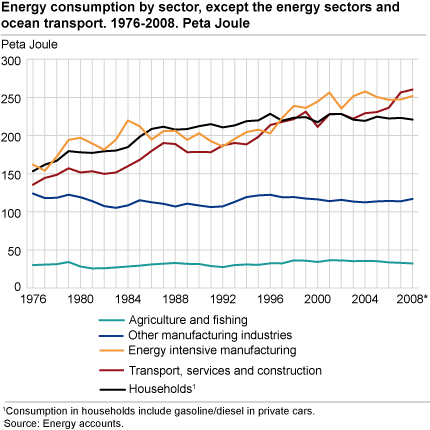Content
Published:
This is an archived release.
Moderate growth in energy consumption
The growth in the overall energy consumption in Norway has been moderate in the last decade, with a 3 per cent increase from 1998 to 2008. From 2007 to 2008, the consumption rose by only 0.4 1 per cent. A larger increase in the oil price than in the electricity price led to higher electricity consumption while oil consumption fell.
The increase in energy consumption in 2008 is partly due to higher consumption of energy commodities used for non-energy purposes due to the start-up of a large anode factory, among other things. Energy consumption excluding non-energy use was almost unchanged 1 from 2007 to 2008. “Non-energy use” is defined as energy commodities that are not used for energy purposes, such as LPG used as input in the production of industrial chemicals, or coal and coke used as input (not fuel) in the production of mineral products or iron or steel.
Modest growth over time
Seen over a longer period, the growth in energy consumption has been relatively modest in spite of growth in the economy and the population, which generally means greater needs for energy. Since 1998, the energy consumption rose by 3 per cent. Energy used for transport purposes had the highest increase in the period 1998-2008, with 14 1 per cent, while consumption in manufacturing industries and other sectors was somewhat reduced. The decline in other sectors can be related to a warmer climate, increasing energy prices and energy use being more efficient than before.
Since 1990, it is only in 1996 that the average temperature has been lower than normal. For the remainder of the years, it has been somewhat warmer than normal compared to the climatic normal for the period 1961-1990. In 2008 and 2007, the temperature was 1.4 and 1.3 o C above normal respectively. Better insulation in buildings, more energy efficient white goods, machinery, electrical equipment and cars and more heat pumps will also limit the growth in the energy consumption. The households’ total energy consumption dropped by 3 per cent from 1998 to 2008, while energy consumption per household fell by 14 per cent in the same period. The latter can also be related to structural changes, for instance that more people are living alone. From 2007 to 2008, the households’ total energy consumption fell by about 1 per cent.
Higher energy prices
The price of heating oil rose considerably from 2007 to 2008. Measured in firm 1998 prices, the price of heating oil doubled from 1998 to 2008. The electricity price also rose in 2008, and came to 89 øre/kWh in current prices for households, but nevertheless it was cheaper to use electricity than heating oil. The households reduced their consumption of both oil and electricity compared to the previous year, but oil products fell mostly. Consumption of district heating rose, but this made up only 1.6 per cent of the household consumption in 2008, and about 1 per cent of overall consumption.
Electricity consumption makes up about half of our energy consumption, and this rose by about 1 per cent from 2007 to 2008. Consumption of oil products, incl. 1 petroleum coke, fell by 3 1 per cent from the previous year if non-energy use is included, and by 2 per cent if non-energy use is excluded.
Lower consumption in refineries
The consumption in manufacturing industries rose by about 1.5 1 per cent from 2007 to 2008, but consumption in refineries, which is included in the energy sector in the balance sheet, dropped significantly by about 12 per cent. Energy consumption for transport purposes was almost unchanged from the pervious year. Energy consumption in fishing and agriculture dropped by about 2 per cent from 2007 to 2008, while consumption to other consumers (private and public services, defence and construction) was on about the same level these years 1 . It can be assumed that the consumption in industries was affected by the production development related to the financial crisis in 2008, and that it rose lower than it otherwise would have done.
High energy consumption in energy producing industries and in foreign transport
Due to comprehensive energy production in Norway, a large part of the energy consumption takes place in the energy sector. Within oil and gas extraction, the energy consumption made up about 52 TWh energy (mainly natural gas and electricity), while an additional 9 TWh was flared off. Together, this makes up 61 TWh, which is higher than the energy used for domestic transport purposes. Furthermore, about 12 1 TWh was used in foreign aviation and shipping, which is energy delivered from Norwegian harbours and airports and used in transport abroad.
More electric cars
The number of electric cars has increased in the past year, and came to 1 750 cars in 2008. The average mileage was about 6 600 km per year according to the vehicle register. Calculated electricity consumption, based on an assumed consumption on 0.18 kWh /km, was about 2 GWh in 2008. The cars can be charged at home, at public charge stations or in companies. About 80 per cent of the cars are privately owned. It is difficult to separate this consumption from other electricity consumption, but it can be assumed that a significant part of this is included in the households’ electricity consumption.
Important announcement: New industry classification
As from 2009, a new version of Eurostat's industry classification, NACE, will be in use. Important changes for manufacturing, mining and quarrying are that publishing and recycling have been moved from manufacturing to a new main industry classification. However, these changes have few implications for total energy use. Click here to read more about the implications for users, calculation and dissemination .
The new industry classification has been implemented in the energy balance sheet in 2007 and 2008, but still not for previous years.
Furthermore, some corrections and improvements have been made to the layout and methodology in the energy balance sheet, which makes it more comparable to international statistics in the field. This means that the figures presented in the balance sheet are different from before, even if data sources and data input have not been changed. Some minor changes have also been made to the tables for the energy account. Read more about this in the supplementary article, on the bottom of the page.
| 1 Corrected at 28 May |
Tables:
- Table 1 Energy sources balance sheet for Norway. 2008. Preliminary figures
- Table 2 Energy balance sheet for Norway. 2008. Petajoule
- Table 3 Energy balance sheet for Norway. 2008. GWh. Preliminary figures
- Table 4 Energy accounts. Extraction, conversion and use of energy goods. 2008. Preliminary figures
- Table 5 Energy accounts. Use of energy goods outside the energy sectors, by industry. 2008. Preliminary figures
- Table 6 Energy accounts. Extraction, conversion and use of energy goods. 2008. Preliminary figures. PJ
- Table 7 Energy accounts. Extraction, conversion and use of energy goods. 2008. Preliminary figures. GWh
- Table 8 Energy sources balance sheet for Norway. 2007.
- Table 9 Energy balance sheet for Norway. 2007. Petajoule.
- Table 10 Energy balance sheet for Norway. 2007. GWh
- Table 11 Energy accounts. Extraction, conversion and use of energy goods. 2007
- Table 12 Energy accounts. Use of energy goods outside the energy sectors, by industry. 2007
- Table 13 Energy accounts. Extraction, conversion and use of energy goods. 2007. PJ
- Table 14 Energy accounts. Extraction, conversion and use of energy goods. 2007. GWh
- Table 15 Energy use in Norway 1998-2008, exclusive international maritime transport and commodities used as raw materials. Renewable and not renewable energy. TWh and per cent.
- Table 16 Net consumption of individual energy bearers. 1976-2007. Red figures revised 22. December 2008
- Table 17 Energy balance 1998-2008*. Petajoule
- Table 18 Percentage share of energy consumption, by individual energy carriers. 1998-2008*
- Table 19 Energy consumption in households. 1990-2008*
- Table 20 Energy consumption in households. 1990-2008*. GWh
- Table 21 Average electricity prices and list prices of selected petroleum products. Excluding and including taxes. 1993-2008
- Table 22 Calculated prices of utilized energy. 1978-2008. Fixed 1998-prices. øre/kWh. All taxes included
- Table 23 Energy balance, total energy 1998-2008. GWh
- Table 24 Supply and use of electricity 1998-2008. GWh
Changes in the energy balance and energy accountOpen and readClose
Consequences of changed industry classification
The changes in industry classification have relatively small implications for the development in energy consumption by sector. The most important change is that publishing and recycling have been moved from manufacturing industries to a new main industry classification (in the service sector). Another difference is that repairing and installation, which was previously a part of the industry where repairs were carried out, has now been separated and classified as repair shops. In the energy balances, repair shops are placed in the service sector. Overall, this means that about 0.76 TWh has been moved from manufacturing industries to the service sector in the energy balance. The energy accounts follow the same principles and definitions as the national accounts (read more about this in “About the statistics”.), where repairing and installation are still classified as manufacturing industries, while publishing and recycling is moved out of the manufacturing industries and included in other sectors. For the energy account, the change means that about 0.45 TWh is moved from manufacturing industries to other sectors.
Changes in principles and definitions in the energy balance and the energy account.
Petroleum coke 1 used for non-energy purposes is placed in the category “consumption for non-energy purposes”, while this was previously added together with coal and coke used as energy in the manufacturing industries. Coal and coke used as reducing agents in the manufacturing industries is considered as energy consumption in the energy balance, because the heat and gas which are generated in these processes often are utilised for energy purposes. 1
Energy used for non-energy purposes is moved to the bottom in the energy balance table, while previously being placed higher up, outside the net domestic consumption of energy.
Two rows are presented for net domestic consumption of energy, with and without energy used for non-energy purposes respectively.
While we previously used gross calorific value to convert natural gas from Sm3 to an energy unit (joule or GWh) we have started to use net calorific value which is 10 per cent lower. For other energy commodities, NCV is consistently used. The difference between gross and net calorific value is that NCV excludes potential energy that is lost due to evaporation of the latent water content in the fuel, and thereby cannot be utilised as energy.
Energy used in defence for military aircrafts etc. is moved from the transport sector to “other sectors” together with public services and private services in the energy balance.
Consumption of tax-exempted diesel is now included in the stationary consumption in manufacturing industries, while this was previously included in the transport sector. The reason is that tax-exempted diesel is not used for transport purposes but is used in machines, lifts etc. by the enterprise.
Energy used by foreign aviation is now separated from the transport sector in the domestic consumption and placed together with foreign shipping higher up in the table. It is no longer a part of net domestic consumption.
Natural gas that is flared off is separated from production and consumption of natural gas in the energy balance, and placed in separate rows. The reason is that this is not consumption but is gas that is burnt for safety reasons in the oil and gas fields. In international statistics on the energy balance, this kind of flared natural gas is not included at all.
Flared natural gas is no longer included in the figures for natural gas in the energy account tables because gas that is flared off is not included in the figures in the national accounts.
Figures for energy used to produce electricity in thermal power plants (power plants that are run by fossil fuels) are improved for 2007 and 2008 so there is now better coherence between the electricity that is produced and the energy used as input to produce the electricity.
Wind power is now categorised as primary energy production together with water falls energy in the energy balance, while this was previously included in secondary energy production.
Petroleum coke is separated from coal coke and placed in a separate column because this is a petroleum product and thereby has other qualities than coal coke.
The statistics is now published as Production and consumption of energy, energy balance and energy account.
Additional information
The statistics are published in spring and autumn. The spring publication is preliminary and aggregated to a larger degree, and only includes figures for energy balance. In the autumn publication, tables are also presented for the energy accounts.
Contact
-
Statistics Norway's Information Centre
E-mail: informasjon@ssb.no
tel.: (+47) 21 09 46 42




